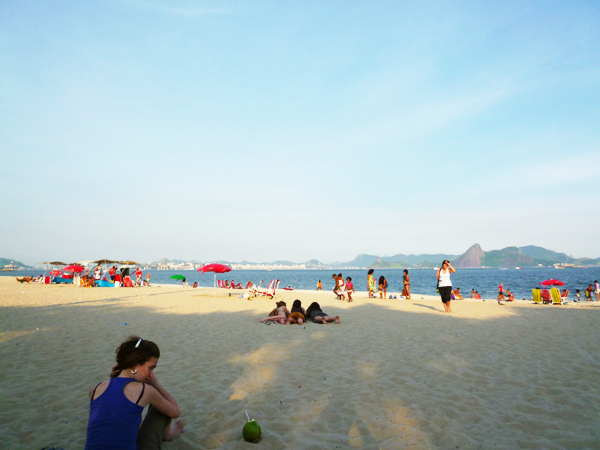This is the second student blog entry of the master’s field trip to Brazil to continue work on the Petropolis Sports-for-Change project in Brazil, in collaboration with Architecture for Humanity.
————————————
Rio de Janeiro: Sunny, hot and humid. Looks like all of us are getting used to the heat and ready to set about the work.
An architectural tour of Rio
Today was the second day of our tour of Rio de Janeiro, the main objective being to visit various important buildings and urban spaces in central Rio, in order to understand the local context and background of our project. The places we chose to visit included those designed by key Brazilian figures like Oscar Niemeyer, Roberto Burle Marx, Afonso Eduardo Reidy, Alfred Agache, Jorge Maria Jáuregui, and Lina Bo Bardi.
1. Igreja de Ns. da Canderalia and Av. Pres Vagas
2. CCBB (Centro Cultural Banco do Brasil) and Fundação Casa França-Brasil
3. Rio de Janeiro Cathedral
4. “Sede do Ministério da Educação e Saúde” Palácio da Cultura Gustavo Capanema do Rio de Janeiro
5. MAM Rio (Museu de Arte Moderna)
6. Parque do Flamengo
We started from Urguaiana station in the morning and finished at Catete station located along one of the main streets, Av. Pres Vagas. Because Petropolis, our project site, is a bit far (approximately 60 km away from the city center) it could seem unnecessary to explore Rio itself, but as foreign architects it is vital to acquire knowledge about the local context starting from the macro level.
A bit of history
Under the administration of the engineer Francisco Pereira Passos, Mayor of Rio de Janeiro from 1902 to 1906, the city initiated an era of great urban renewal. The core of the city went through a period of intensive construction work, which destroyed the last vestiges of its colonial urban design. With the political motivation for rebuilding dirty cramped alleys formed by precarious airless dwellings in order to eliminate epidemic diseases, central Rio was modeled on the monumental splendor perceived as characteristic of the great European capital cities. Through the opening and widening of streets and avenues a great number of poor colonial houses, where the low-income communities used to live, were demolished.
This is actually how favelas, slums that occupy patches all over the city, came to be, when those who lost their homes rebuilt their own dwellings where possible around the city.

One of the remaining colonial buildings at the edge of a main street
Some historical buildings still remain, like a church and public buildings that have been adapted to new uses. Upon our visits to one of these historical areas, we could see how this may have once represented a greater part of Rio, the narrow streets and colorful buildings a much more people-friendly design that serves the local community. Ironically, this atmosphere is now mostly characteristic to the favelas.
Throughout our tour, we observed a very active and energized city center buzzing with offices workers, vendors, tourists… On the whole, people very much support the rapid economic growth of Brazil. If you visit this city only as a tourist it is difficult to grasp the level of sacrifice endured by the local inhabitants of Rio. One of our intentions of visiting the city center is definitely to explore the relationship between physical spaces and people, as well as the consequences of changes made by architects and urban planners over the years.
For example, The Rio de Janeiro Cathedral was built between 1964 and 1979 and replaced a series of old churches that had served as cathedrals since 1676. Surrounded by several sky scrapers, it has a capacity for 20,000 people, though in my opinion, it does not really serve the local people anymore.
In the case of the Museum of Modern Art, you can detect the city’s attempt at modernization, reflected by the official verse that declares its purpose:
“The cultural influence of a modern art museum is not only drawn from the collection of works of art and of courses of study and conferences held there, but more particularly the creation of their own intellectual atmosphere in which the artist is to enrich their own work and ideas in which the public can absorb the artistic culture required by the mind of modern man.”

MAM Rio (Museu de Arte Moderna)
Closing the gaps
In the end, these kinds of developments created both rich and poor, the center and the favelas. Our question is how we can begin to close those two huge gaps. Hopefully this workshop will enable us to find even a small piece of the puzzle.
The beach, our final destination just beside the Flamengo park (another development project), gives us a clue. Here, it seems, there is no difference between rich or poor. A culturally-rooted and common public space where people spend their time without judging their neighbor.
by Yuya Fukada





